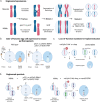Engineering apomixis in crops
- PMID: 37199785
- PMCID: PMC10195744
- DOI: 10.1007/s00122-023-04357-3
Engineering apomixis in crops
Abstract
Apomixis is an asexual mode of reproduction through seeds where progeny are clones of the mother plants. Naturally apomictic modes of reproduction are found in hundreds of plant genera distributed across more than 30 plant families, but are absent in major crop plants. Apomixis has the potential to be a breakthrough technology by allowing the propagation through seed of any genotype, including F1 hybrids. Here, we have summarized the recent progress toward synthetic apomixis, where combining targeted modifications of both the meiosis and fertilization processes leads to the production of clonal seeds at high frequencies. Despite some remaining challenges, the technology has approached a level of maturity that allows its consideration for application in the field.
© 2023. The Author(s).
Conflict of interest statement
R. Mercier is listed as inventor in patents covering the use of MiMe to engineer apomixis.
Figures

References
-
- Asker SE, Jerling L. Apomixis in plants. London: CRC Press; 1992.
Publication types
MeSH terms
LinkOut - more resources
Full Text Sources
Other Literature Sources

